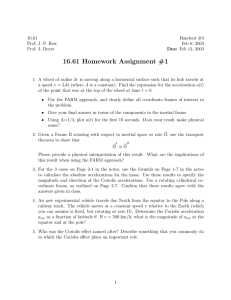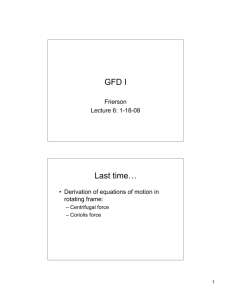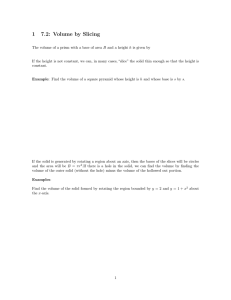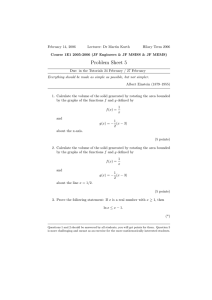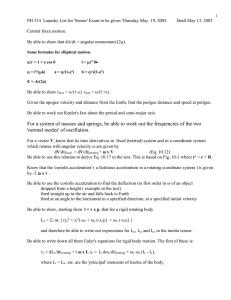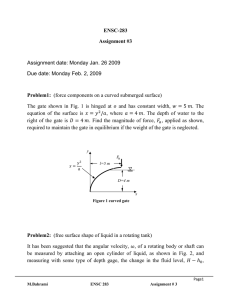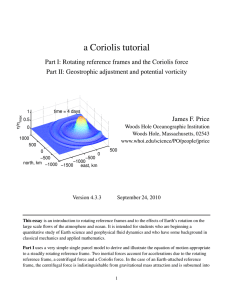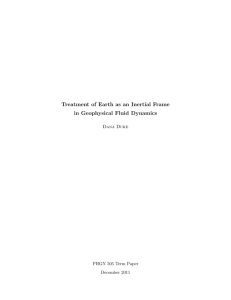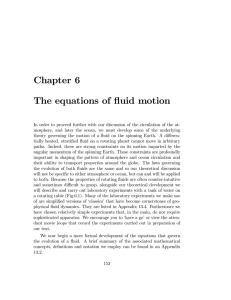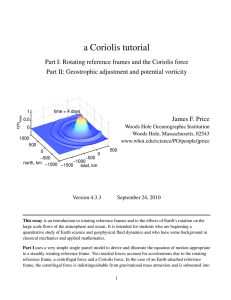MA3D1 Fluid Dynamics Support Class 6 - Rotation and Instability 1 Rotation
advertisement
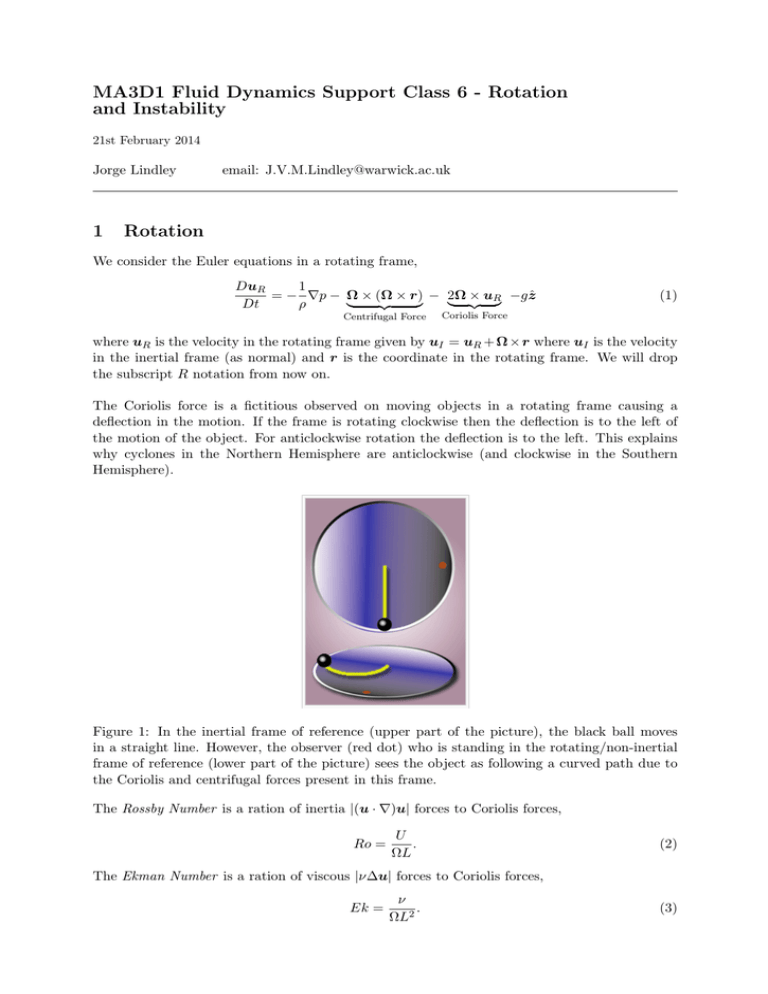
MA3D1 Fluid Dynamics Support Class 6 - Rotation
and Instability
21st February 2014
Jorge Lindley
1
email: J.V.M.Lindley@warwick.ac.uk
Rotation
We consider the Euler equations in a rotating frame,
DuR
1
= − ∇p − Ω × (Ω × r) − 2Ω × uR −gẑ
| {z }
|
{z
}
Dt
ρ
Centrifugal Force
(1)
Coriolis Force
where uR is the velocity in the rotating frame given by uI = uR + Ω × r where uI is the velocity
in the inertial frame (as normal) and r is the coordinate in the rotating frame. We will drop
the subscript R notation from now on.
The Coriolis force is a fictitious observed on moving objects in a rotating frame causing a
deflection in the motion. If the frame is rotating clockwise then the deflection is to the left of
the motion of the object. For anticlockwise rotation the deflection is to the left. This explains
why cyclones in the Northern Hemisphere are anticlockwise (and clockwise in the Southern
Hemisphere).
Figure 1: In the inertial frame of reference (upper part of the picture), the black ball moves
in a straight line. However, the observer (red dot) who is standing in the rotating/non-inertial
frame of reference (lower part of the picture) sees the object as following a curved path due to
the Coriolis and centrifugal forces present in this frame.
The Rossby Number is a ration of inertia |(u · ∇)u| forces to Coriolis forces,
Ro =
U
.
ΩL
(2)
The Ekman Number is a ration of viscous |ν∆u| forces to Coriolis forces,
Ek =
ν
.
ΩL2
(3)
2
Inertial Waves in a Rotating Fluid
Suppose an inviscid, incompressible fluid is rotating uniformly with angular velocity Ω =
(0, 0, Ω). The linearised rotating equations are
∂u
1
+ 2Ω × u = − ∇p, ∇ · u = 0.
∂t
ρ
(4)
We find the pressure equation by taking the divergence and curl (looking at the z component)
of (4),
1
1
∂u ∂v
∂u
= − ∆p.
+ 2Ω × u = − ∇p ⇒ 2Ω
−
(5)
∇·
∂t
ρ
∂y ∂x
ρ
∂u ∂v
∂u
1
∂ ∂u ∂v
= 2Ω
(6)
∇×
+ 2Ω × u = − ∇p ⇒
−
+
∂t
ρ
∂t ∂y
∂x
∂x ∂y
We also take the partial derivative with respect to z of the z component of
∂ ∂u
1
∂2
∂ ∂
+ 2Ω × u = − ∇p ⇒ 2 p = −ρ
w.
∂z ∂t
ρ
∂z
∂z ∂t
(7)
Then putting these results together we get the pressure equation, we begin by multiplying (7)
by 4Ω2 and using incompressibility
2
∂u ∂v
∂ 2 ∂u ∂v
∂2
2 ∂
2 ∂
p
=
4Ω
ρ
+
=
2Ωρ
−
=
−
∆p
(8)
4Ω
∂z 2
∂t ∂x ∂y
∂t2 ∂y
∂x
∂t2
2
2
∂
2 ∂
⇒
∆ + 4Ω
p = 0.
(9)
∂t2
∂z 2
We look for solutions p = p̂ei(kx+ly+mz−ωt) , putting this into (9) gives the dispersion relation,
ω2 =
4Ω2 m2
.
k 2 + l2 + m2
The phase and group velocities are
∂ω ∂ω ∂ω
2Ω
ωk
cph =
, cg =
,
,
=
(−km2 , −lm2 , m(k 2 + l2 ))
2
|k|
∂k ∂l ∂m
|k|4
(10)
(11)
Taking the dot product shows orthogonality,
(k, l, m) · (−km2 , −lm2 , m(k 2 + l2 )) = −k 2 m2 − l2 m2 + m2 (k 2 + l2 ) = 0.
Example 1. (Question from McWilliams, Fundamentals of Geophysical Fluid Dynamics)
Consider inertia-gravity waves with small amplitude fluctuations in 3D Boussinesq equations
with ρ = ρ0 (1 − αT ) for basic state of rest with uniform rotation f = f0 and stratification
ρ̄(z) = ρ0 (1 − N02 z/g) in an unbounded domain. The linearised equations are
∂t u − f v = ∂x φ
(12)
∂t v + f u = ∂y φ (Momentum equations)
(13)
∂t w = ∂z φ + b
∇ · u = 0 (Incompressibility)
2
∂t b + N w = 0 (Conservation of internal energy)
with φ = p/ρ0 the geopotential and b = gρ/ρ0 the buoyancy.
(a) Derive the dispersion relation.
(14)
(15)
(16)
Answer: Look for solutions u = u0 ei(kx+ly+mz−ωt) , v = v0 ei(kx+ly+mz−ωt) , w = w0 ei(kx+ly+mz−ωt) ,
φ = φ0 ei(kx+ly+mz−ωt) , b = b0 ei(kx+ly+mz−ωt) . Follow a similar method as for the inertial waves
in a rotating fluid and substitute solutions into the equation to get the dispersion relation,
1
2
(k + l2 )N 2 + m2 f 2 2
ω=±
(17)
k 2 + l 2 + m2
(This calculation is messy, but don’t worry about it too much.)
(b) Demonstrate that ω depends only on the direction of u and not its magnitude K = |u|.
Answer: Express k = (k, l, m) in polar form u = (K, θ, λ) with k = K cos(θ) cos(λ), l =
K cos(θ) sin(λ), m = K sin(θ). Then
1
ω = ±(N 2 cos2 (θ) + f 2 sin2 (θ)) 2 .
(18)
So it depends on the orientation θ but is independent of the magnitude K.
(c) Show that N and f are the largest/smallest frequencies allowed for inertial-gravity modes.
(Assume f < N ).
Answer: If f < N then
max |ω| = N, for m = 0, l = 0, k = K (θ = 0, nπ for n ∈ N)
min |ω| = f, for m = K, l = 0, k = 0 (θ = nπ/2 for n odd).
Figure 2: Plot of the dispersion relation (18).
(d) Demonstrate that the phase and group velocities
ω
ωk
∂ω
cg = = 2 , cph =
=
k
K
∂k
∂ω ∂ω ∂ω
,
,
∂k ∂l ∂m
,
are orthogonal and have opposite signed vertical components for the inertial-gravity mode.
Answer:
cph =
1
ωk
ω
∂ω
= 2 (k, l, m), cg =
=
(k(N 2 − ω 2 ), l(N 2 − ω 2 ), m(f 2 − ω 2 )).
2
K
K
∂k
ωK 2
Taking the dot product shows they are orthogonal, cg · cph = 0. Also
sign[cph ] = sign[ω]sign[m], sign[cg ] = sign[ω]sign[m]sign[f 2 − ω 2 ],
and since f < N
ω2 =
so f 2 − ω 2 < 0.
(k 2 + l2 )N 2 + m2 f 2
(k 2 + l2 )f 2 + m2 f 2
>
= f2
k 2 + l 2 + m2
k 2 + l 2 + m2
3
Rayleigh’s Inflection Point Theorem
A necessary condition for the linear instability of an inviscid shear flow U (z) is that U 00 (z) should
change sign somewhere in the flow (this is called an inflection point). Note that there is no claim
here that any velocity profile with an inflection point is unstable.
4
Kelvin Helmholtz Instability
Let one deep layer of inviscid fluid with density ρ2 flow with uniform speed U over another deep
layer of fluid with density ρ1 at rest. Consider a small travelling wave disturbance with interface
η(x, t) = Re[Aei(kx−ωt) ].
Figure 3: Small disturbance on the interface.
Using the deep water equation the interface conditions are
∂φ1
∂η ∂φ2
∂η
∂η
=
,
=
+u ,
∂z
∂t
∂z
∂t
∂x
also using Bernoulli and hydrostatic pressure p = ρgη we have
∂φ1
∂φ2
∂2η
∂φ2
ρ1
+ gη − ρ2
+u
+ gη = T 2
∂t
∂t
∂x
∂x
(19)
(20)
where T is the surface tension. Using these conditions and the form of the disturbance on the
interface η we find the dispersion relation
h
i
1
1
(21)
ω=
ρ2 U k ± [(ρ1 + ρ2 )|k|(k 2 T + (ρ1 − ρ2 )g) − ρ1 ρ2 U 2 k 2 ] 2 .
ρ1 + ρ2
Suppose ρ1 > ρ2 (bottom heavy fluid), write ω = ωR + iωI then we require wI > 0 for small
disturbances to grow and become unstable, hence for instability we require
1
ρ1 ρ2 U 2
g
> min (ρ1 − ρ2 )
+ |k|T = 2[(ρ1 − ρ2 )gT ] 2 .
k
ρ1 + ρ2
|k|
Figure 4: Cloud formations caused by Kelvin-Helmholtz instability.
